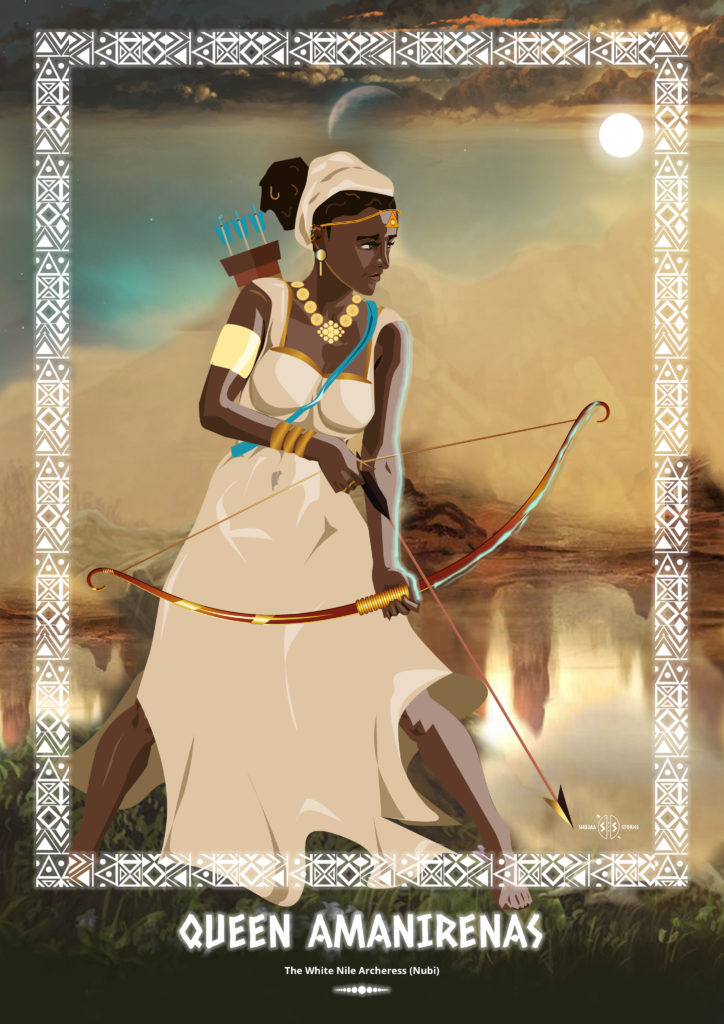Queen Amanirenas: The White Nile Archeress


Many centuries ago, there was a famous African kingdom known as the Land of Kush. This kingdom went by other names, including Ta-Seti, but it was most famously known as the Nubi Kingdom. Geographically, it was located south of the Ancient Egyptian Empire and was known for its people who were excellent archers.
The Nubians, as they were called, were revered as one of the best hunters and warriors. And one might imagine a mass of Nubian men who displayed this prowess, but in actuality, Nubian women too wielded bows and arrows as both hunters and fighters. Within the community were distinguished women who fiercely ruled the Nubian people as their queens, with the most memorable being the great Queen Amanirenas – the second Queen of the Nubi Kingdom.
Queen Amanirenas ruled between 40 BC and 10 BC and her kingdom sat between the great Nile and the Atbara River. At such a strategic location, her kingdom was abundant with water which ensured that her people never lacked food even in the driest of seasons. At the start of her reign, Cleopatra VII was the Queen of Egypt, and like her fellow Queen, Queen Amanirenas too left a lasting impression on her people.
In 31 BC a war known as the Battle of Actium took place in Egypt between the Roman and Egyptian Empires. Rome, under Emperor Caesar Augustus, defeated Egypt, and Augustus automatically became ruler. Egypt became part of the Roman Empire, but Augustus was eager to extend his kingdom further south into the Nubi Kingdom.
Word travelled fast, and soon landed in the ear of the Queen, who realised she had no time to waste. She gathered her council to strategize on a way to protect her kingdom, knowing well that the Nubian warriors were far less in comparison to Augustus’s great army. To plan almost seemed a futile attempt because Augustus’s victory in Egypt was known and many had come to fear him.
But as Queen, Amanirenas was determined to protect her kingdom and so she ordered her warriors to go to war with Augustus’s army. The plan was to launch a surprise attack. She gathered her strongest 30,000 men and ensured they were armed with swords, bows and arrows. It was another time to display their prowess; a time to make history.
On the day of the attack, she was at the battlefront with her son by her side. Horses galloped and warriors bellowed as they descended upon the Romans in Egypt. The scene was gruesome by the end of the battle, but the Queen had emerged victorious; she had captured three major Roman cities! As a statement of their triumph, the Nubian warriors defaced several of Augustus’s statues. Victory was truly theirs – or at least for a moment.
Augustus launched a counter attack, and his soldiers invaded and destroyed Amanirenas’s capital, capturing several of her people with the intention of selling them as slaves. This time Rome was the winning side, but not for long. Queen Amanirenas’ was still free and living in her kingdom. She struck back, this time even more ferociously.
The battle seemed never ending, but after three years a peace treaty was that was favourable to the Nubians was signed. Emperor Augustus agreed to take his army out of Egypt.
The Nubian Dynasty survived another 400 years before colonialism interrupted. Nubians were drafted into the British army (their resistance tactics and weapons were no match for European riffles) to fight in the Second World War (1939-1945). When the war ended, they were dispatched to Nairobi where they settled in the outskirts of the Central Business District. The Nubian community slowly sprung up in Kibra, an informal settlement in Nairobi.
Despite the legacy of the great Queen Amanirenas, the discrimination her people who settled in Nairobi face cannot be ignored. Even after Kenya attained self-rule and thereafter independence in 1963 and 1964 respectively, Nubians have been denied basic citizenship rights. All of independent Kenya’s governments have viewed them as foreigners despite their presence in Kenya for almost a century and their community included as one of Kenya’s 44 communities.
#ShujaaStories



